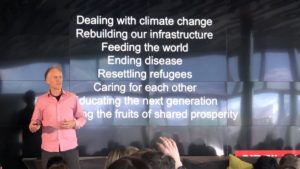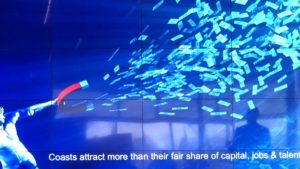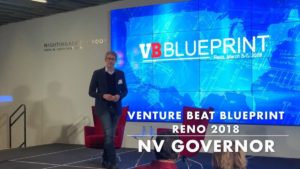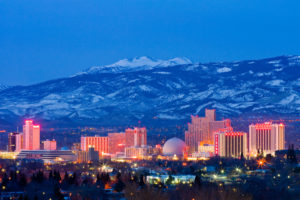
Blueprints for an Entrepreneurial Future in America’s Heartland
At VentureBeat Blueprint 2018, leaders from regional tech hubs talked extensively about the sources of their success and plans for the future.
The big question of 2018 is: how can America’s heartland — especially cities that have been overlooked in the recent obsession with Silicon Valley and New York — build an uplifting future, strong communities and good jobs. However, this year’s VentureBeat BLUEPRINT conference broke the idea that Silicon Valley is the benchmark of entrepreneurship.

One over-arching insight that emerged from the conference is that the next objective for all heartland cities is to double down on this progress, and establish the ideas and language necessary to carve out a space in the public consciousness.
The Blueprints for a New Future
Blueprint, means a plan — this is derived from blue print as in a design schematic or architectural map. In its original and narrow definition, the word refers to a reproduction of a technical drawing, created using a copying method that relies on chemicals that turn blue in the light.
Actual blueprints haven’t been in widespread use since the middle of the 20th century — but they still shape our language.
The same is true for Silicon Valley, most redolently in the proliferation of other Silicons: Silicon Prairie, Silicon Alley, Silicon Roundabout. Do any of these entrepreneurial areas have anything to do with silicon microprocessors? Do they even want to emulate the Valley?
Listening to attendees and contributors, we distilled some major ideas and tips on how heartland cities can can do so.
These ideas include the tips with which we began the story, which startups and entrepreneurial organizations can use right now.
- Bootstrap entrepreneurial ecosystems — capital infrastructure will follow when there is something to invest in
- Identify parts of your ecosystem that are lacking and invest in them
- Invest in arts and culture; embrace the historical character of the city
- Invest and engage in your community, especially via education and training
Once entrepreneurs and organisations take these steps, they create the space necessary to take a more values-led approach, using the following mantras:
- Say ‘yes,’ go where it’s easy to ‘say yes’
- Embrace serendipity
- Remember that it’s OK to be boring
- Play to your strengths
These ideas saturated the speakers and attendees’ blueprints for change. They are rust-belt-to-tech-hub operating principles.
Why Entrepreneurs are Getting Out of the Valley
More and more entrepreneurs are leaving Silicon Valley, feeling the pressures of high cost of living and low quality of life. Meanwhile, many feel stifled by homogenous thinking and a cut-throat culture that highlights competition over collaboration.
Mayor of Reno & Gary, says there has been phenomenal shift of Mayor's initiating inclusive Entrepreneurship efforts across small & mid size cities, we have to provide the energy, lead & goal for the city we represent, we are essentially ground zero – #Blueprint2018 – #kickingass pic.twitter.com/Ub7FDMd0VO
— Thenu S (@Thenu) March 6, 2018
People today have a different definition on what success is, one that has less to do with money and more to do with community — @DanSpaulding1 #BluePrint2018 pic.twitter.com/B1aPReq2nb
— Entrepreneur Quarterly (@eqstl) March 6, 2018
.@IraEhrenpreis tells @jswartz and #Blueprint2018 @dblpartners partnering with entrepreneurs who are missionary, not mercenary. Says public private partnerships are a key piece of the blueprint for success stories of tech growth in the heartland, like @Tesla in Nevada. pic.twitter.com/r6QDxxq89Z
— Christina Quick Henderson (@ChrisQuick) March 6, 2018
Why companies are leaving Silicon Valley #Blueprint2018 pic.twitter.com/mTDQwJ5y1C
— Terri Cooper (@tcooper555) March 6, 2018
Even Silicon Valley heavyweights like Peter Theil are moving resources out of the Valley:
Silicon Valley Is Over, Says Silicon Valley via @NYTimes very timely article #Blueprint2018 https://t.co/oupFYnQi9w
— Douglas Erwin (@douglas_erwin) March 5, 2018
Meanwhile, entrepreneurs and other organisations want to find ways to distribute success more effectively, something that seems unlikely to happen in in more traditional tech hubs:
Perfect quote to end this talk by @timoreilly at #Blueprint2018 “We all do better when we all do better.” pic.twitter.com/siQ6NePOez
— Charlie Brock (@cebrock) March 6, 2018
At VB’s BLUEPRINT, the businesses, mission driven organizations, governments and public-private partnerships present showcased their success stories and set out how they intend to achieve a fairer, more prosperous, and more distributed future.
Here are some of the blueprints:
Reno Nevada
Nevada, and particularly Reno, told a dramatic success story. For example, SWITCH uses collaborations with local educational institutions to help local employees to learn the skills they need to get jobs at the company.
https://twitter.com/ahhensel/status/971167729083326469
Meanwhile, no state tax, plenty of open space and an appetite on the part of the state government for growth and investment has created space for companies to take big bets. The most ambitious of these has to be Tesla’s Gigafactory, which, when complete, will be the largest building on Earth.
.@thekazteam welcomes #Blueprint2018 to hometown of #Reno, #Nevada. Points to strategic effort to leverage the region’s existing strengths in advanced #manufacturing to attract @Tesla and other tech firms, bring a tech boom and jobs to an economy hit hard by the recession. pic.twitter.com/QlRmy4xPlh
— Christina Quick Henderson (@ChrisQuick) March 6, 2018
Meanwhile, Nevada has invested in arts, culture and, thus, the state’s quality of life, helping to make it more attractive for entrepreneurs and investors.
https://twitter.com/GovSandoval/status/971073775600001024
Nevada lost 175,000 jobs during the financial crisis — the state has since generated 200,000. Meanwhile, Reno achieved a complete turnaround.
Reno reversed a 14% unemployment rate, put 14K people back to work, and reached full employment.
Where did they get started?
For Reno, it was about building the base: investing in advanced manufacturing, attracting data centers to the region. @VentureBeat #Blueprint2018 pic.twitter.com/c1p6gm7tfy
— Entrepreneur Quarterly (@eqstl) March 6, 2018
All the states represented at the conference have designed blueprints that draw on their history. Nevada’s blueprint, at least in part, is to become a home for people’s most radical and ambitious ideas. This is true of Nevada, as it catalyses the same ‘out West’ freedom for which it was famous in the past.
Tennessee
Tennessee has nurtured multiple hubs, utilising existing skills to create the foundation for a more diverse economy. Ultimately, however, this is dependent on people taking action before the traditional business infrastructure (VC funds, co-working spaces, incubators etc.) is in place.
Totally–and we know the capital follows entrepreneurship.
— Launch Tennessee (@LaunchTN) March 6, 2018
https://twitter.com/ahhensel/status/971095605874323456
Chattanooga, in particular, has transformed itself from a comparative desert of entrepreneurship into a high-tech base and investment center. Launch Tennessee CEO Charlie Brock’s excellent presentation put across what a night and day transformation this was:
The extraordinary growth of Tennessee in the last 8 years, as told in 2 photos.
Charlie Brock, CEO of @LaunchTN talks about building a statewide network of entrepreneurs and support orgs to help Tennessee win. #Blueprint2018 pic.twitter.com/Dj2dq43yPn
— Entrepreneur Quarterly (@eqstl) March 6, 2018
If you ask someone about Nashville, Tennessee, chances are they’ll mention music / entertainment. Eventbrite chose to invest in Nashville largely for this reason:
https://twitter.com/ahhensel/status/971144424876007424
As such, Tennessee’s blueprint uses this skill and reputation as the foundation for a bigger and more entrepreneurial future.
Ohio
Some states have have focused on solving particular problems that previously held back their startup ecosystems. In particular, Rev 1 Ventures helped Columbus Ohio to ensure that companies don’t hit the buffers when they grow to the point where there are no new capital sources for them.
Lightning talk from Columbus Ohio #blueprint2018 problem in 2012 was lack of VC funding, especially follow in capital that helps startups cross the chasm … #STL focusing on this too – trying to create funds to “cross the valley of death” https://t.co/RLrOHUYsq6
— Jonathan Allen (@jc1000000) March 6, 2018
As a result, some people who left the state for Silicon Valley for this reason are pleasantly surprised at the news.
What! Since I left Columbus in 2012, $727MM VC Funding, most active seed region is US, & 48% increase in VC funding. W/ @SavvyCMO at @Rev1Ventures #ohio #heartlands #startupCbus #Blueprint2018 pic.twitter.com/mUrPY5oyAG
— Zach Ferres (@zcferres) March 6, 2018
With focused decision-making and concerted action like this, cities that weren’t renowned for entrepreneurship can become best-in-class.
.@SavvyCMO Kristy Campbell highlights @Rev1Ventures efforts to pull together business community and state support to strategically grow #Columbus, #Ohio into a @KauffmanFDN #1 city in 2016 for scaling startups. #Blueprint2018 pic.twitter.com/fWJHNGCTo2
— Christina Quick Henderson (@ChrisQuick) March 6, 2018
Utah
Of course, Entrepreneurs moving to the heartland from the coasts would be unwise to shun Coastal partnerships and capital altogether. Many of the states represented at Blueprint took care to surprise the audience with the levels of connectivity on offer.
For example, transportation from San Francisco and Los Angeles to Utah is so convenient that Thomas Wadsworth — Dir. of Corporate Growth and Business Development at Utah Governor’s Office of Economic Development — proudly described the state as ‘just another California suburb.’
Utah “just another Californian suburb” #blueprint2018 – simple idea but speaks to the concept of developing “mega-regions” pic.twitter.com/6LpJu7qr6z
— Jonathan Allen (@jc1000000) March 6, 2018
Clearly, a significant part of Utah’s blueprint is to draw, fully, upon the State’s geographic gifts.
Pittsburgh
Pittsburgh was Blueprint’s dark horse. Eric Daimler, CEO of Spinglass, explained how Pittsburg is only fourth place in the entire U.S. in terms of venture rounds per million residents. Pittsburg’s 40.8 rounds puts it behind only Silicon Valley, Boston and Austen.
https://twitter.com/ahhensel/status/971092293397565440 — correct to 40.8 per MILLION
Meanwhile, both Uber and Oculus chose the city as development base for their products.
Pittsburgh is center of autonomous vehicle development for Uber and also where they develop Oculus Rift for Facebook #blueprint2018
— Jonathan Allen (@jc1000000) March 6, 2018
Deimler described how, during the city’s heavy industrial past, people would change shirts twice per day to deal with the filthy smog that stained clothes. The city has since reinvented itself as clean and green.
.@ead Eric Daimler of #Pittsburgh PA shows his city’s transformation from tired industrial hub to vibrant tech center competing for @amazon HQ2#Blueprint2018 pic.twitter.com/S7vG2jSEEe
— Christina Quick Henderson (@ChrisQuick) March 6, 2018
This rapid growth has made the city extremely accessible to tech workers who are interested to buy property and make the city their home.
https://twitter.com/ahhensel/status/971092584272572416
Pittsburg has completely redefined itself as a city, achieving top living standards and making generally a great place to live.
Listening to @ead pitch #Pittsburgh at #blueprint2018 – one of your tribe @smithmegan @ruthef, right?! #digital44 pic.twitter.com/cSK1K7COzV
— Mitali Chakraborty (@GoLeftMitali) March 6, 2018
These victories bolster the city’s ability to attract a smart, discerning workforce. This fact is a vital part of its blueprint for the future, which includes a bid for Amazon HQ2.
San Antonio
Danny Garcia, CEO of Geekdom and representing San Antonio at Blueprint, emphasized that not all meaningful progress for heartland cities needs to come from groundbreaking, change-the-world inventions. Garcia sees a prosperous future for his city in building the stuff that sits in the background, does its job, and makes the world work:
San Antonio’s blueprint for growth – “play to our strengths” … “we may not be home to the ‘next big thing’ but we can be the home for ‘the plumbing of the internet.’” #Blueprint2018 pic.twitter.com/wHcH6vBIlh
— Jonathan Allen (@jc1000000) March 6, 2018
Garcia also emphasized that startup ecosystem is not a chemistry set where administrators can cook up a unicorn. Instead, communities need to do three things well:
A lesson for economic development leaders at #Blueprint2018: You can't control a community.
But you CAN:
1. Celebrate shared victories
2. Focus on your strengths
3. Strive for density, in offices and in city centers @dgarc007 CEO of @Geekdom at @VentureBeat #Blueprint2018 pic.twitter.com/SfxbSR8trU— Entrepreneur Quarterly (@eqstl) March 6, 2018
To return to a theme from earlier, capital can’t exist without investments, meaning that entrepreneurs and city evangelists have to sell people on the idea before the money and financial support flows in.
Love this point – just get started. Sell the vision and capital will follow. Cities can think just like startups when it comes down to it https://t.co/Q1nA4WSml9
— Jonathan Allen (@jc1000000) March 6, 2018
Vision like this has helped San Antonio put all the businesses below on the map.
In 6 years mission driven orgs like Geekdom have helped put companies on this map of San Antonio (there were none before) #Blueprint2018 pic.twitter.com/HKiVZb7aXI
— Jonathan Allen (@jc1000000) March 6, 2018
This, alongside being comfortable with being the plumbing of the internet, should prove to be two pillars of San Antonio’s future success.
Madison, Wisconin
Sometimes a heartland city’s entrepreneurial story relies on more than a grain of irony. Tiffany Apczynski, Zendesk’s VP of Public Policy and Social Impact explains how the company needed an IT support person in the Central Time Zone. They set up an employee in Madison WI and, an amazingly short time later, the company’s Madison outpost had grown to a team of nine.
https://twitter.com/ahhensel/status/971167069973573632
Meanwhile, a sense place will be central to Zendeskdesk’s operations moving forward:
https://twitter.com/ahhensel/status/971171363477057536
And this means not just embracing America’s heartland, but also contributing to under-developed parts of extremely prosperous coastal cities.
.@Tifferatti of @Zendesk — "When we opened our office in the Tenderloin neighbourhood of San Francisco, we decided not to be the sort of company that would go to a new place but never engage with the local community." #blueprint2018
— Entrepreneur Quarterly (@eqstl) March 6, 2018
Zendesk has derived success from taking a chance on novel bets, while capitalizing on serendipity. These things and more will comprise Zendesk — and Madison’s — blueprint for the future.
Gary, Indiana
Karen Wilson — Mayor of Gary, Indiana — was asked to explain her top priority as Mayor. She described that it was: helping to nurture her constituents’ sense of hope.
"What's your biggest challenge as a mayor right now?"
"I could say the obvious things like budget, and roads. But more than that — it's inspiring hope in our residents. They have heard politicians make promises that they don't keep." #Blueprint2018 pic.twitter.com/CWfACs4Off
— Entrepreneur Quarterly (@eqstl) March 6, 2018
To return to yet another common theme, the Mayor emphasized that if a city wants to promote its entrepreneurship, it needs also to nurture a long-lasting and sustainable base of art and culture.
A cupcake contest can be economic development, too.
Mayors like @karenaboutgary are thinking about how to improve quality of life, and build arts and culture that stand the test of time #Blueprint2018 from @VentureBeat https://t.co/FTeJQ9pH06
— Luke Babich (@LukeBabich) March 6, 2018
As for the advantages of building a startup ecosystem in a small city, Wilson explained that a small city’s lower red-tape burden makes it much easier to take action and to change things.
There are a lot of advantages coming from a small- or mid-sized city: there is less red tape and less overhead.
A motivated mid-tier city can rapidly diversify its economy. @karenaboutgary talks about investing in her workforce and drawing talent at #Blueprint2018
— Entrepreneur Quarterly (@eqstl) March 6, 2018
As the Mayor identified, people are tired of politicians not delivering on their promises. Gary, Indiana’s blueprint, therefore, is empowered by the city’s ability to say yes.




